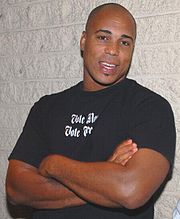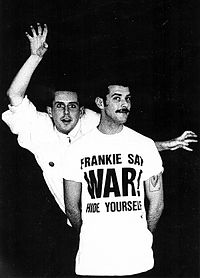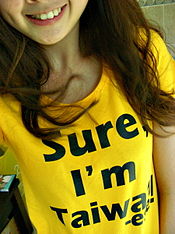- T-shirt
-
For the Shontelle song, see T-Shirt (song).
A T-shirt (T shirt or tee) is a style of shirt. A T-shirt is buttonless and collarless, with short sleeves and frequently a round neck line.
T-shirts are typically made of cotton fibers (sometimes others), knitted together in a jersey stitch that gives a T-shirt its distinctive soft texture. T-shirts can be decorated with text and/or pictures, and are sometimes used to advertise (see human billboard).
T-shirt fashions include many styles for both men and women, and for all age groups, including baby, youth, teen, adult and elderly sizes.
The T-shirt evolved from undergarments used in the 19th century, through cutting the one-piece "union suit" underwear into separate top and bottom garments, with the top long enough to tuck under the waistband of the bottoms. T-shirts, with and without buttons, were adopted by miners and stevedores during the late 19th century as a convenient covering for hot environments.
T-shirts, as a slip-on garment without buttons, originally became popular in the United States when they were issued by the U.S. Navy during or following the Spanish American War. These were a crew-necked, short-sleeved, white cotton undershirt to be worn under a uniform. It became common for sailors and Marines in work parties, the early submarines, and tropical climates to remove their uniform "jacket", wearing (and soiling) only the undershirt.[1]
 A T-shirt with a protest art message on it in the mid-2000s.
A T-shirt with a protest art message on it in the mid-2000s.
Named the T-shirt due to the shape of the garment's outline, they soon became popular as a bottom layer of clothing for workers in various industries, including agriculture. The T-shirt was easily fitted, easily cleaned, and inexpensive, and for this reason it became the shirt of choice for young boys. Boys' shirts were made in various colors and patterns. By the Great Depression, the T-shirt was often the default garment to be worn when doing farm or ranch chores, as well as other times when modesty called for a torso covering but conditions called for lightweight fabrics.[1]
Contents
World War II
Following World War II, it became common to see veterans wearing their uniform trousers with their T-shirts as casual clothing, and they became even more popular in the 1950s after Marlon Brando wore one in A Streetcar Named Desire, finally achieving status as fashionable, stand-alone, outer-wear garments.[2]
In the mid-1980s, the white T-shirt became fashionable after the actor Don Johnson wore it with an Armani suit in Miami Vice.[1]
They can also be used to carry commercial advertising, souvenir messages and protest art messages. Beginning in the late 1960s, the T-shirt became a medium for wearable art. Psychedelic art poster designer Warren Dayton pioneered several political, protest, and pop-culture art T-shirts featuring images of Cesar Chavez, political cartoons, and other cultural icons in an article in the Los Angeles Times magazine in late 1969.
Today, many notable and memorable T-shirts produced in the 1970s have now become ensconced in pop culture. Examples include the bright yellow happy face T-shirts, The Rolling Stones tops with their "tongue and lips"[3] logo, and Milton Glaser's iconic "I ♥ N Y” design.
Trends
T-shirts were originally worn as undershirts. Now T-shirts are worn frequently as the only piece of clothing on the top half of the body, other than possibly a bra or an undershirt (vest). T-shirts have also become a medium for self-expression and advertising, with any imaginable combination of words, art, and even photographs on display.[4]
A T-shirt typically extends to the waist. Variants of the T-shirt, like the tank top, crew neck, A-shirt (with the nickname "wife beater"), muscle shirt, scoop neck, and V-neck have been developed. Hip hop fashion calls for "tall-T" T-shirts which may extend down to the knees. A 1990s trend in women's clothing involved tight-fitting "cropped" T-shirts short enough to reveal the midriff. Another popular trend is wearing a short-sleeved T-shirt of a contrasting color over a long-sleeved T-shirt. This is known as "layering".
Decoration
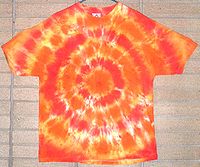 An example of a tie-dyed T-shirt.
An example of a tie-dyed T-shirt.
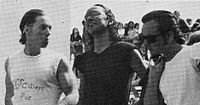 Teenagers at a Los Angeles high school, 1974. All are wearing T-shirts; the one on the far left has a hand-written slogan.
Teenagers at a Los Angeles high school, 1974. All are wearing T-shirts; the one on the far left has a hand-written slogan.
In the early 1950s several companies based in Miami, Florida, started to decorate T-shirts with different resort names and various characters. The first company was Tropix Togs, under founder Sam Kantor, in Miami. They were the original license for Walt Disney characters that included Mickey Mouse and Davy Crockett. Later, other companies expanded into the T-shirt printing business, including Sherry Manufacturing Company, also based in Miami. Sherry started in 1948 by its owner and founder Quinton Sandler as a screen print scarf business and evolved into one of the largest screen printed resort and licensed apparel companies in the United States.
In 1959, plastisol, a more durable and stretchable ink, was invented, allowing much more variety in T-shirt designs.
In the 1960s, the ringer T-shirt appeared and became a staple fashion for youth and rock-n-rollers. The decade also saw the emergence of tie-dyeing and screen-printing on the basic T-shirt. In the late 1960s Richard Ellman, Robert Tree, Bill Kelly, and Stanley Mouse set up the Monster Company in Mill Valley, California, to produce fine art designs expressly for T-shirts. Monster T-shirts often feature emblems and motifs associated with the Grateful Dead and marijuana culture.[5] Additionally, one of the most popular symbols to emerge out of the political turmoil of 1960s were T-shirts bearing the face of Marxist revolutionary Che Guevara.[6]
Screen printing
The most common form of commercial T-shirt decoration is screen-printing. In screen-printing, a design is separated into individual colors. Plastisol or water based inks are applied to the shirt through mesh screens which limits the areas where ink is deposited. In most commercial T-shirt printing, the specific colors in the design are used. To achieve a wider color spectrum with a limited number of colors, process printing (using only cyan, magenta, yellow and black ink) or simulated process (using only white, black, red, green, blue, and gold ink) is effective. Process printing is best suited for light colored shirts. Simulated process is best suited for dark colored shirts. Very few companies continue to use water-based inks on their shirts. The majority of other companies that create shirts prefer to use plastisol due to the ability to print on varying colors without the need for color adjustment at the art level.
Specialty inks trend in and out of fashion and include shimmer, puff, discharge, and chino based inks. A metallic foil can be heat pressed and stamped onto any plastisol ink. When combined with shimmer ink, metallics give a mirror like effect wherever the previously screened plastisol ink was applied. Specialty inks are more expensive to purchase as well as screen and tend to appear on garments in boutiques.
Other methods of decoration used on T-shirts include airbrush, applique, embroidery, impressing or embossing, and the ironing on of either flock lettering, heat transfers, or dye-sublimation transfers. Laser printers are capable of printing on plain paper using a special toner containing sublimation dyes which can then be permanently heat-transferred to T-shirts.
In the 1980s, thermochromatic dyes were used to produce T-shirts that changed color when subjected to heat. The Global Hypercolour brand of these was a common sight on the streets of the UK for a few years, but has since mostly disappeared. These were also very popular in the United States among teenagers in the late 1980s. A downside of color-change garments is that the dyes can easily be damaged, especially by washing in warm water, or dye other clothes during washing.
At the turn of the 21st century, designing custom T-shirts online became more popular. Popular websites began to use digital printing (such as Direct to Garment or DTG printing) to allow customers to design their own T-shirts online with no minimum orders. In the beginning, DTG could not print well on dark garments; however, with the help of some online T-Shirt retailers, printer manufacturers such as T-Jet have all but perfected the process, providing consumers with many more printing options.[7]
Expressive messages
Since the 1980s, T-shirts have flourished as a form of personal expression.[4]
Screen printed T-shirts have been a standard form of marketing for major consumer products, such as Coca-Cola and Mickey Mouse, since the 1970s. However, since the 1990s, it has become common practice for companies of all sizes to produce T-shirts with their corporate logos or messages as part of their overall advertising campaigns. Since the late 1980s and especially the 1990s, T-shirts with prominent designer-name logos have become popular, especially with teenagers and young adults. These garments allow consumers to flaunt their taste for designer brands in an inexpensive way, in addition to being decorative. Examples of designer T-shirt branding include Calvin Klein, FUBU, Ralph Lauren and The Gap. These examples also include representations of rock bands, among other obscure pop-culture references. Licensed T-shirts are also extremely popular. Movie and TV T-shirts can have images of the actors, logos, and funny quotes from the movie or TV show. Often, the most popular T-shirts are those that characters wore in the film itself (e.g., Bubba Gump from Forrest Gump and Vote For Pedro from Napoleon Dynamite). Designer Katharine Hamnett, in the early 1980s, pioneered outsize T-shirts with large-print slogans. The early first decade of the 21st century saw the renewed popularity of T-shirts with slogans and designs with a strong inclination to the humorous and/or ironic. The trend has only increased later in this decade, embraced by celebrities, such as Britney Spears and Paris Hilton, and reflected back on them, too ('Team Aniston').[citation needed] The political and social statements that T-shirts often display have become, since the first decade of the 21st century, one of the reasons that they have so deeply permeated different levels of culture and society.[citation needed] The statements also may be found to be offensive, shocking, or pornographic to some. Many different organizations have caught on to the statement-making trend, including chain and independent stores, websites, and schools. A popular phrase on the front of T-shirts demonstrating T-shirts' popularity among tourists is the humorous phrase "I did _____ and all I got was this lousy T-shirt." Examples include "My parents went to Las Vegas and all I got was this lousy T-shirt." T-shirt exchange is an activity where people trade their T-shirts they are wearing. Some designs specifically write on the shirt "trade with me".[citation needed]
Football shirts
 An FC Barcelona football shirt.
An FC Barcelona football shirt.
Whilst not properly described as T shirts, Replica Football shirts, normally replicas of the sports shirts worn by athletes, are commonly found in the Football market, with increased popularity after the commercialization of football in the 1990s. With the rise of advertising in the mid 20th century, sponsors' logos began to appear on the shirts, and replica strips were made available for fans to purchase, generating significant amounts of revenue for clubs.
Since the mid 1970s, Football shirts have been made of lightweight polyester, although prior to this they were typically of a heavyweight cotton design.
In the United Kingdom, several clubs have been accused of price fixing, and Manchester United were in fact fined in 2003.[8] The high prices, and the fact that new designs are brought out each season for many clubs, mean that shirts are often the subject of satire among football fans, but many still consider it an obligation to wear them. Many Newcastle United and Manchester United fans buy their clubs' black and white striped and red and white shirts, respectively. The prices have also led to fans buying fake shirts which are imported into the UK from Thailand, Malaysia, and Far East Asia; many sellers on eBay now indicate that their shirt are genuine.[9]
World record
 Nick Umbs t-shirts record stunt. Georgetown, Washington, D.C. 2007
Nick Umbs t-shirts record stunt. Georgetown, Washington, D.C. 2007
Nick Umbs of Burke, Virginia, broke the U.S. record for most T-shirts worn at one time.[10] Nick donned 183 T-shirts between sizes small and 10XL during a six-hour session in October 2007. Nick's record-breaking stunt was taped by the Discovery Channel for the show Is It True?.[11]
See also
- Concert T-shirt
- Football kit
- Inkjet transfer
- Long-sleeved T-shirt
- Polo shirt
- Printed T-shirt
- Protest art
- Raglan sleeve
- Replica
- Wet T-shirt contest
References
- ^ a b c Harris, Alice. The White T. HarperCollins, 1996.
- ^ "A Streetcar Named Desire - AMC filmsite". Filmsite.org. 1947-12-03. http://www.filmsite.org/stre.html. Retrieved 2010-10-26.
- ^ File:The Rolling Stones Tongue Logo.png
- ^ a b Sally Larsen with Neeli Cherkovski, Japlish, Pomegranate Art Books, San Francisco, 1993, ISBN 1-56640-454-1
- ^ Monster T-SHIRT ART, Monster Corporation catalog #3, Mill Valley 1974
- ^ The Most Famous Statement T-Shirts by SoJones Asmara, September 10, 2009
- ^ Online Companies Help Improve DTG Printing on Dark Garments
- ^ "Business | Man Utd fined for price fixing". BBC News. 2003-08-01. http://news.bbc.co.uk/1/hi/business/3116353.stm. Retrieved 2010-10-26.
- ^ By Darragh MacIntyre (2006-03-03). "Business | The Fake Football Shirt Sting". BBC News. http://news.bbc.co.uk/1/hi/business/4768454.stm. Retrieved 2010-10-26.
- ^ "Man Breaks U.S. T-Shirt Record - Local News | News Articles | National News | US News". FOXNews.com. 2007-10-19. http://www.foxnews.com/story/0,2933,303563,00.html. Retrieved 2010-10-26.
- ^ "Is It True? Nearly Fatal T-Shirt Record Attempt". YouTube. http://www.youtube.com/watch?v=nCRvrFtSbZg. Retrieved 2010-10-26.
Men's undergarments Upper body Lower body Bikini · Boxer briefs · Boxer shorts · Briefs (slip, Y-fronts) · Fundoshi · G-string · Jockstrap (athletic supporter) · Compression shorts · Thong · TrunksFull body Long underwear (long johns)Hosiery Historical Brands 2(x)ist · Abercrombie & Fitch · American Eagle · American Apparel · Andrew Christian · aussieBum · Bonds · BVD · California Muscle · Calvin Klein · C-IN2 · Diesel S.p.A. · DKNY · Dolce & Gabbana · Emporio Armani · Fruit of the Loom · Hanes · Hugo Boss · Jockey International · Joe Boxer · Mundo Unico · Pringle · Saxx Apparel · John Smedley's · Stanfield's · Under Armour · XTG Extreme GameCategories:- T-shirts
Wikimedia Foundation. 2010.

